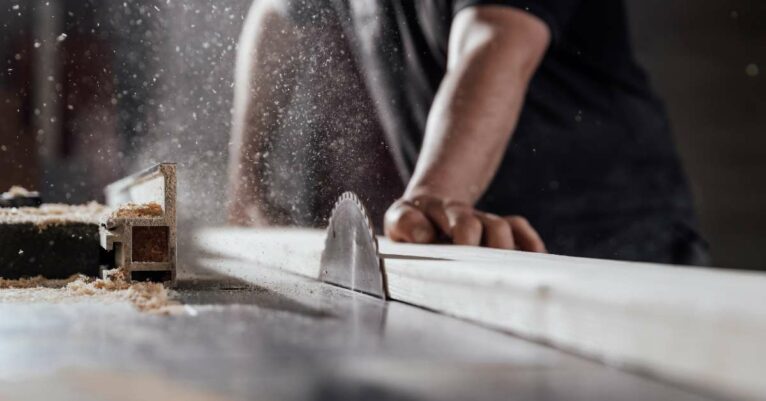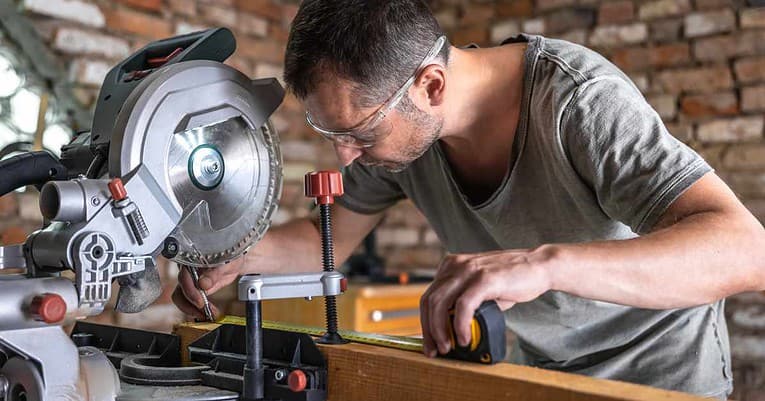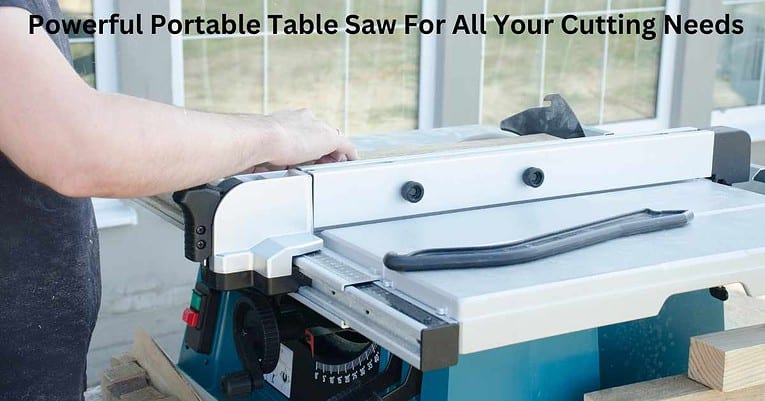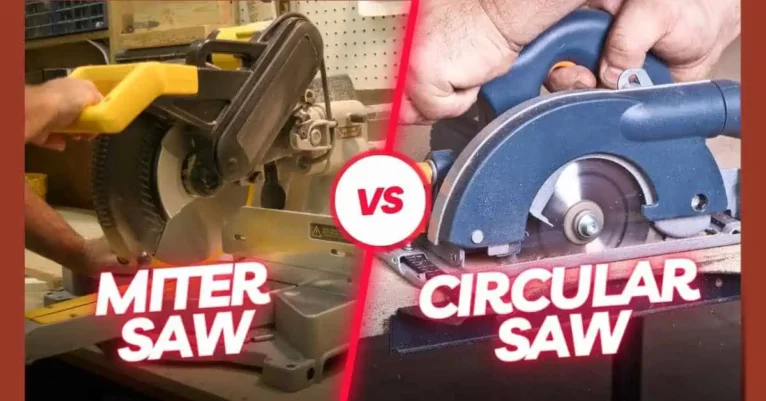Single vs Double Bevel Miter Saw: Which One Should You Choose?
When it comes to miter saws, one of the most important decisions you’ll have to make is whether to go for a single-bevel or a double-bevel model. Both types have their pros and cons, and the choice largely depends on your needs and preferences. In this article, we’ll take a closer look at the differences between single vs double bevel miter saws, their features, brands, and safety tips, to help you make an informed decision.
You Might Be Interested In:
- Miter Saw vs Table Saw: Which One is the Best for You?
- 10 Best Sliding Compound Miter Saws
- Top 10 Miter Saw Stand with wheels
- Miter Saw or Circular Saw: Which Is Best for You?
Single vs Double Bevel Miter Saw
Before we dive into the specifics of each type, let’s define what we mean by “bevel” in a miter saw. Essentially, a bevel is an angle at which the saw blade can tilt to make angled cuts. In a single bevel miter saw, the blade can only tilt in one direction, typically to the left. This means that you’ll have to flip the workpiece to make bevel cuts in the other direction. In a double-bevel miter saw, the blade can tilt in both directions, which makes it more versatile and faster for making compound cuts.
Pros and Cons of Single Bevel Miter Saws
Single-bevel miter saws are generally more affordable, compact, and easier to use for beginners or hobbyists. They are also lighter and require less maintenance, as they have fewer moving parts. However, they may limit your cutting capacity and accuracy if you frequently work with larger or thicker materials that require angled cuts in both directions. Moreover, they may slow you down if you have to constantly flip the workpiece or adjust the saw’s position for bevel cuts.
Pros and Cons of Double Bevel Miter Saws
Double-bevel miter saws are more expensive, heavier, and bulkier than single-bevel models, but they offer more flexibility and efficiency for professional woodworkers or DIY enthusiasts who frequently tackle complex projects. With a double-bevel miter saw, you can make bevel cuts in either direction without having to flip the workpiece or adjust the saw’s position. This can save you time and effort, especially if you’re working with larger or thicker materials that require multiple angled cuts. Additionally, some double-bevel miter saws have larger blades and more powerful motors, which can improve their cutting capacity and speed.
Choosing the Right Bevel Range and Blade Size
Regardless of whether you opt for a single or double bevel miter saw, you’ll need to consider the bevel range and blade size that best suits your needs. The bevel range is the maximum angle at which the saw blade can tilt, usually measured in degrees. The wider the bevel range, the more angled cuts you can make without having to adjust the saw’s position. Some miter saws have a bevel range of up to 60 degrees, while others have a more limited range of 45 or 50 degrees.
The blade size refers to the diameter of the saw blade, usually measured in inches. The larger the blade size, the deeper and wider the cuts you can make. However, larger blades also require more power and may generate more sawdust or noise. The most common blade sizes for miter saws are 10, 12, and 15 inches, although there are some models with smaller or larger blades.
Single vs Double Bevel Miter Saw: Other Features to Consider
In addition to the bevel range and blade size, there are other features that may affect your choice of miter saw. For example, some miter saws have a laser guide or LED light that helps you align the blade with the cut line.
Other features that may be useful include a dust collection system, a sliding fence, a digital display, and a soft start mechanism. A dust collection system can help keep your workspace clean and reduce health risks from inhaling sawdust. A sliding fence can provide additional support and accuracy when cutting longer or wider materials. A digital display can show you the exact angle and bevel settings of the saw blade, which can help you make precise cuts. A soft start mechanism can gradually increase the speed of the blade, which can reduce the wear and tear on the motor and improve safety.
Brand Comparison: DeWalt vs Bosch vs Makita vs Festool vs Hitachi vs Ryobi
There are several reputable brands that produce high-quality miter saws, each with its own strengths and weaknesses. Some of the most popular brands are DeWalt, Bosch, Makita, Festool, Hitachi, and Ryobi. Let’s compare some of their most popular miters saw models and see how they stack up against each other in terms of features, performance, and price.
DeWalt DW715 vs Bosch CM12SD vs Makita LS1019L
DeWalt DW715 is a single bevel miter saw with a 12-inch blade and a bevel range of up to 48 degrees. It has a powerful 15-amp motor that can deliver up to 4,000 RPM, which can handle most cutting tasks with ease. The saw also has a precise miter system that can adjust to 11 positive stops, which can provide accurate and repeatable cuts. However, the saw is relatively heavy and bulky, which may not be ideal for mobile or space-constrained workshops.
Bosch CM12SD is a dual bevel miter saw with a 12-inch blade and a bevel range of up to 47 degrees in both directions. It has a patented axial-glide system that allows for wider crosscuts and better alignment than traditional rail-based systems. The saw also has a laser guide that can help you align the blade with the cut line and a soft start mechanism that can reduce the noise and vibration of the motor. However, the saw is quite expensive compared to other models, and may not be suitable for beginners or occasional users.
Makita LS1019L is a dual bevel miter saw with a 10-inch blade and a bevel range of up to 48 degrees in both directions. It has a unique direct-drive gearbox that can deliver more power and smoother operation than belt-driven or gear-driven systems. The saw also has a digital display that can show you the exact angle and bevel settings of the blade, and a dust collection system that can capture up to 75% of the sawdust. However, the saw may be too heavy or bulky for some users, and it may require some assembly or adjustment out of the box.
Festool Kapex KS 120 vs Hitachi C12RSH2 vs Ryobi TSS120L
The Festool Kapex KS 120 is a dual bevel miter saw with a 10-inch blade and a bevel range of up to 47 degrees in both directions. It has a unique dual laser system that can project two laser lines for more accurate cutting, and a fine bevel adjustment that can provide precise cuts at any angle. The saw also has a compact and ergonomic design that can be easily transported and stored, and a soft start mechanism that can prolong the life of the motor. However, the saw is one of the most expensive models on the market and may require some specialized accessories or parts.
Hitachi C12RSH2 is a dual bevel miter saw with a 12-inch blade and a bevel range of up to 45 degrees in both directions. It has a laser marker system that can provide accurate and visible cutting lines, and a compact slide system that can save up to 12 inches of workspace. The saw also has a vibration-reducing system that can improve comfort and accuracy, and a dust collection system that can capture up to 95% of the sawdust. However, the saw may not have the most powerful motor or the most precise miter system compared to other models and may require some adjustment or calibration for optimal performance.
Ryobi TSS120L is a dual bevel miter saw with a 12-inch blade and a bevel range of up to 45 degrees in both directions. It has a laser guide that can help you align the blade with the cut line and a compact design that can fit in small or tight spaces. The saw also has a blade brake that can stop the blade within seconds for improved safety, and a three-year warranty that can provide peace of mind. However, the saw may not have the most durable or precise components compared to other models, and may not be suitable for heavy or frequent use.
DIY Projects and Safety Tips for Miter Saw Users
Whether you’re a professional woodworker or a DIY enthusiast, there are many creative and useful projects that you can make with a miter saw. Some popular projects include building furniture, frames, shelves, decks, and fences. However, it’s important to follow some basic safety tips when using a miter saw to prevent injuries or accidents. Some of these tips include:
- Always wear eye and ear protection, as well as gloves and a dust mask if necessary.
- Keep your workspace clean and organized, and avoid clutter or distractions.
- Keep your hands and fingers away from the blade, and use a push stick or clamp if necessary.
- Make sure the blade is properly aligned and tightened before use, and adjust the blade guard and the fence if necessary.
- Use a stable and level work surface, and secure the workpiece firmly before cutting.
- Do not wear loose clothing or jewelry that may get caught in the blade, and do not use the saw if you’re feeling tired, stressed, or distracted.
Conclusion
Single vs double bevel miter saws are both useful and versatile tools that can help you make precise and angled cuts for various projects. By considering their features, brands, and safety tips, you can choose the best miter saw that fits your needs and budget. Remember to always follow the manufacturer’s instructions and safety guidelines, and to seek professional help or advice if you’re unsure about how to use the saw properly. Happy cutting!











